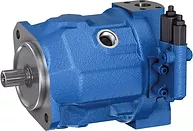Avoiding Devastating Cavitation Damage
Hydraulic pump cavitation is a devastating problem. It is the likely cause of symptoms such as excessive noise, energy use, pump damage, and pump failure.
Although each of these symptoms can indicate other concerns, cavitation is one of the most troublesome, as it can compromise the entire hydraulic system. It is the second leading cause of hydraulic pump failure behind hydraulic fluid contamination.
For this reason, let’s look at some of the causes of cavitation, how to recognize its occurrence, as well as how to prevent damage and keep hydraulic systems healthy.
What is cavitation and what causes it on hydraulic pumps?
Cavitation occurs from the formation of vapors and the resulting breakdown inside the hydraulic pump. Excessive vacuum conditions on the inlet (supply) side of the pump create steam bubbles within the hydraulic fluid which then travel to the discharge (pressure) side, at which point they collapse. The moment of collapse is when cavity damage occurs.
Cavitation is particularly destructive to metal surfaces, which have little flexibility. The explosive force of the cavitation causes friction and abrasion, which eventually leads to damage and, if left untreated, will lead to pump failure.
Although the main cause of cavitation is poor plumbing, there are many other ways in which this destructive force can begin.
Some of these other possible causes of cavitation in a hydraulic pump include:
flow restrictions
High oil viscosity
clogged filters
pipe blockage
poor tube design
Conditions that do not meet the requirements of NPSH (Net Positive Suction Head)
Determine the cavitation of the hydraulic pump
Most often, cavitation is audible, and is recognized by a recognizable sound. However, there are other visual cues that are accurate clues when the pump is experiencing cavitation.
When you are concerned that cavitation occurs in a hydraulic pump, pay attention to:
Sound: A hissing sound from the pump could indicate a slight cavitation, while a massive sound that might best be described as “glass balls in a can” could indicate severe explosions.
Physical Evidence: Metal debris found in a hydraulic oil filter during routine maintenance could indicate a cavity in the pump.

Damage: If the pump and its components are visibly damaged, it may be the result of cavitation and the pump requires immediate inspection.
Troubleshooting and prevention
If end users encounter cavitation, there are some easy troubleshooting practices that can fix the problem, limit damage, or help avoid the problem altogether.
Here are some preventive and troubleshooting steps you can take.
solving problems
Check filters and strainers for metal debris
Determine the available absolute pressure (NPSHa) and the required (NPSHr) at the suction port of the pump.
Check the viscosity of the oil and ensure it is suitable for the application and weather conditions
protection
Increase the fluid level around the suction area
Increase the pump suction line size to reduce turbulence
Maintain the appropriate oil viscosity for your components and based on the climatic/environmental conditions in which the pump is operating
Best practices to avoid cavitation
Continuing with a regular maintenance schedule for your hydraulic systems and looking for signs of cavitation is the best preventative measure that may actually include the above steps. However, there are some practices that can further protect hydraulic systems from bore damage.
These practices include:
Ensure hydraulic pumps are immersed in suction, i.e. use a direct path from the tank to the pump to use gravity and atmospheric pressure to operate the pump rather than relying on vacuum pressure to draw fluid.
Use a suitable vent cap on the tank, or compressed (3-5 psi) with an air system or pressure vent cap
Ensure that the supply line shut-off valves are fully open and free of restriction.
Check tank filter for buildup (if present)
Consider laminar flow and reduce noise and turbulence at the pump inlet by ensuring the length of the supply hose is at least 10 times its diameter.
Getting the job done can save your hydraulic system
By starting with knowing what cavitation is, its causes, and distinctive ways to identify it, end users can avoid taking the path that could lead to a compromised hydraulic system.
Another way to avoid systemic and hydraulic pump damage due to cavitation is to maintain preventative practices and measures.
In the end, it is always best to avoid a cavity by knowing the symptoms and doing the work to diagnose, correct and prevent a cavity.
Another Blogs: Denison’s innovative beginnings

